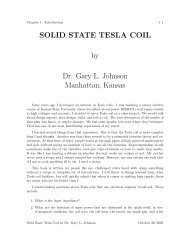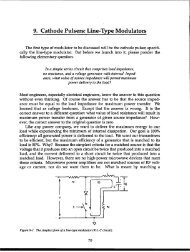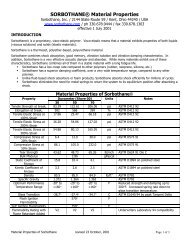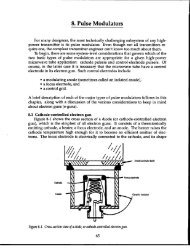3.6M north10.pdf - Dean-O's Toy Box
3.6M north10.pdf - Dean-O's Toy Box
3.6M north10.pdf - Dean-O's Toy Box
You also want an ePaper? Increase the reach of your titles
YUMPU automatically turns print PDFs into web optimized ePapers that Google loves.
Cathode Pulsers: Hard-Tube Modulators (10) 151<br />
The phase slope with time is40,000°/s. -Because there are360° per cycle, the<br />
frequency shift, which is exactly the same as a Doppler shift, is 40,000/360, or 111<br />
Hz. This effect has been referred to by some as the “serrodyne” effect because of<br />
its serrated, or sawtooth, waveform, which is caused in this case by voltage<br />
removal from a capacitor. Before there were modern frequency synthesizers with<br />
phase-locked loops and other means of assuring phase coherency between transmitter<br />
and receiver local-oscillator frequencies, the serrodyne effect was actually<br />
used to achieve the frequency offset between them. This was done by applying a<br />
linear ramp of voltage with its short-duration reset timed so that the period of<br />
the resulting sawtooth waveform was the same as the desired receiver intermediate<br />
frequency. This sawtooth waveform was applied between helix and cathode<br />
of a low-power, continuous-wave TWT that had a relatively high phase-pushing<br />
factor. With proper adjustment of the amplitude of the sawtooth waveform, the<br />
RF output would be at the desired local-oscillator frequency.<br />
Figure 10-1 showed the most gradual of topological changes that could ease a<br />
designer from the line-type, half-control-switch modulator technology into the<br />
hard-tube, full-control-switch modulator technology. Figure 10-3 shows four further<br />
refinements. The first refinement, illustrated in Fig. 10-3a, simultaneously<br />
replaces the soft-tube switch with the hard-tube switch and the artificial transmission<br />
line PFN with a capacitor energy store, which is coupled with a series faultcurrent-limiting<br />
resistance. In the case of a switch-tube arc, however, all of the<br />
charge and energy stored in the capacitor will be dumped. Charge and energy<br />
will be transferred to the load connected to the puk+transformer secondary until<br />
the transformer core saturates, which, in a well-engin~md application, will not<br />
be much longer than the longest normal pulse. Up until this time, the cur~nt in<br />
the discharge loop will only be about 15!40 greater than the normal load current,<br />
assuming that the normal switch-tube voltage drop was approximately 10% of<br />
the initial capacitor voltage and that the load is a 3/2-power, space-charge-limited,<br />
diode-type electron gun.<br />
When the pulse transformer core saturates, the transfer of energy and charge<br />
to the load terminates, but things get much worse for the faulted switch tube.<br />
Remember from the discussion on half-control switches that an arc in vacuum is<br />
a very good conductor with almost negligible voltage drop. Current is now<br />
limited only by the series resistance of the capacitor. What is more, the action<br />
integral of the discharge, or<br />
J i2dt,<br />
is equal to the stored energy divided by the value of series resistance. (joules/<br />
ohm is the equivalent of ampere~seconds.) If the arc in the switch tube was<br />
between the &ode and one OFthe small-diameter wires that makeup the control<br />
grid, the action integral determines whether the grid wire will fuse. If it does<br />
and if enough grid wire is involved, the voltage on the grid will no longer<br />
effectively cut off anode current in the interpulse interval.<br />
For low intrapulse voltage droop, the capacitor’s stored energy should be







